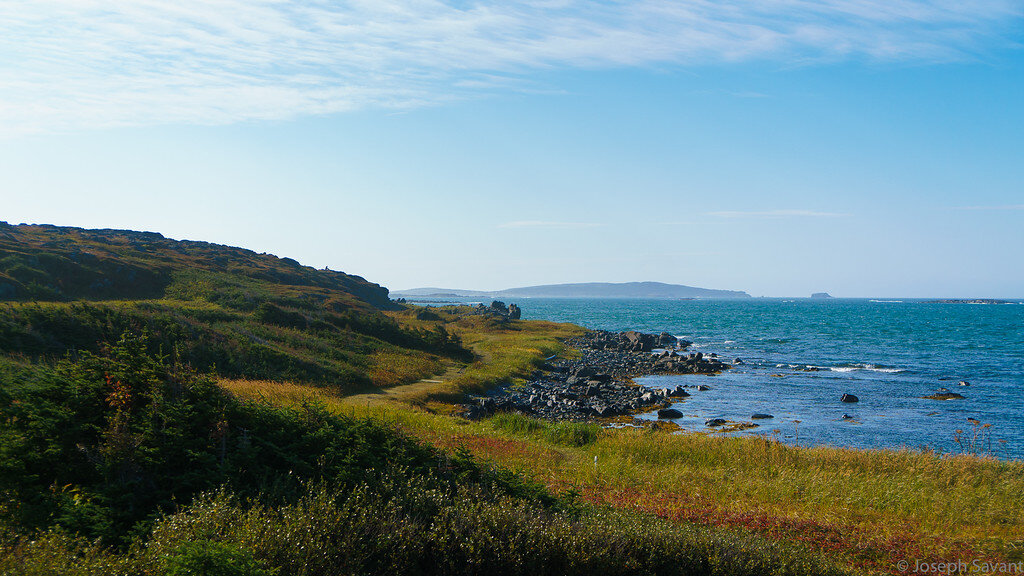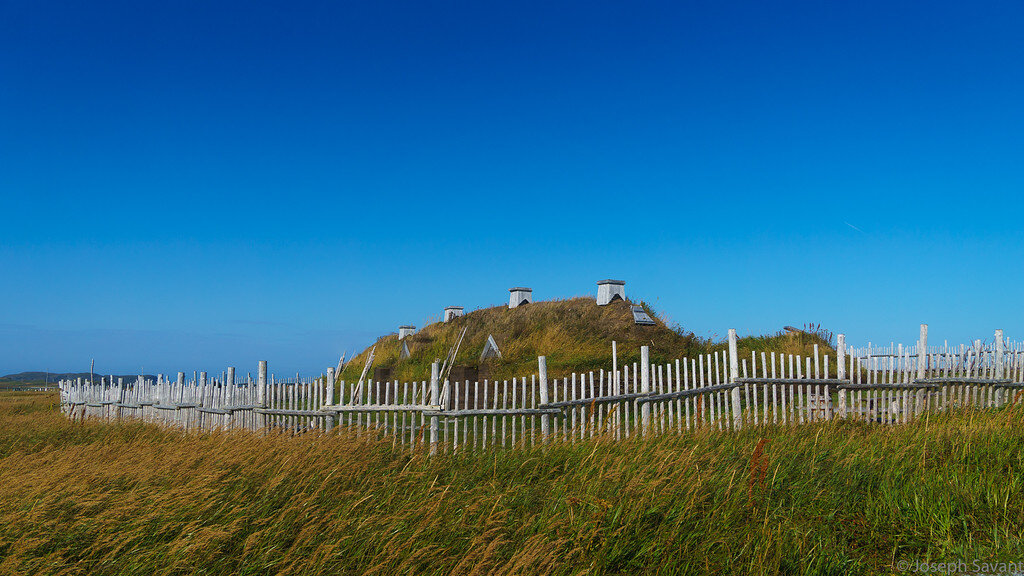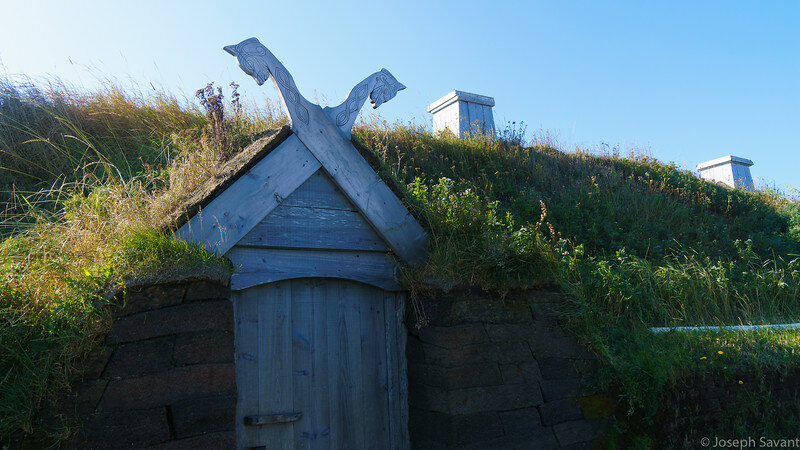It was another clear morning and cold in Port Au Choix. The winds off the water were even stronger than the previous day, and in a minute or two my face shield and video camera lens were coated with the smeary salt film as I rode out of the community.
The beauty of the road north continued along the water, occasionally drifting away from the beach through wooded areas. Here and there, pickup trucks carried loads of firewood in the back or pulled flatbed trailers covered with cut wood.
I began to see small roadside garden plots along the highway. The soil was rich and black and here and there were small gardening patches marked with homemade fences. Some were abandoned and overgrown, but most had been maintained and several had people harvesting vegetables.
I pulled off at differing communities and rode through the small towns, enjoying looking at the small homes and fishing boats.
My exploration of pullouts and side roads added to the length of the day, though the distance towards my goal of L’anse Aux Meadows wasn't that far. The old Viking settlement at the northern end of the island has intrigued me and was my primary goal of coming to Newfoundland, or at least a good excuse to make the ride.
In many areas along the highway, the scrub vegetation was low enough to expose huge areas of bare gray rock on the landscape and the nickname of the island, “The Rock”, was very appropriate.
I passed the turn off for L’anse Aux Meadows and continued a short few miles to the town of St. Anthony, seeking a butt break and some hot coffee. I had arrived around two in the afternoon and planned to go to the site for a couple of hours before finding my bed and breakfast. I stopped at the Tim Horton's and as I was taking my helmet off was approached by a man in his North Face and Patagonia attire. He introduced himself, saying he had followed me for couple of blocks to ask a few questions about traveling by motorcycle. He and his partner were currently traveling in a Ford F350 crew cab diesel with a fancy camper on the back. They were exploring Canada after having been to the Overland Expo. He had a 2010 BMW GSA but had not utilized it yet and was in the process of educating himself on how to set it up for a long-term trip he planned. We talked for a while and I inspected his camper set up, which was very well done.
Afterwards, I sucked down a hot coffee and hopped back on the bike. I got a bit of a rush as I neared the park, realizing my goal was in sight. Rolling into the parking lot, the visitor is greeted with a steel silhouette of a group of Vikings on top of a mound. The visitor center is accessed via walkway and was quite nice. I got into a conversation with a lady in the souvenir shop who informed me that the snowmobiling in Newfoundland was top notch with highly maintained trails. She said she and her husband and family would take snowmobile trips of 400 or 500 km over four day weekends. She said she loves the winter and the snow.
The view over the location of the small settlement from the porch of the visitors center was one I took in for a while, before slowly taking the wooden walkway towards the rocky beach. For me it was a mesmerizing experience, standing in the wind and looking out at the sea, buried in thoughts of such a barren remote location and the difficulties in sailing the small boats across the sea and establishing an outpost. The wind made the experience timeless.
The small bay where Viking boats were pulled up on shore for repairs, nails and other metal items being made in the blacksmith shed in the colony.
Interpretive sculpture at the entrance to the catwalks leading through the archaeological remains of the site
The foundations of the small sod buildings still remain, along with a reconstructed residence replete with three or four reenactors. Though it was a bit chilly outside, the structures were very warm from the fires inside. The reenactors did a really good job of explaining various aspects of life at the time.
Reconstructed sod lodge house
The interiors were very comfortable and the fires made the place warm and inviting. Re-enactors are a wealth of information.
My wonderings about how harsh a winter climate would be here for a colony were somewhat soothed by the sod structures, which offered great insulation and warmth. They wouldn’t be a bad place to live…
Though there's not a Nordic bone in my body, for some reason I was really attracted to being there. I sat for a while in what seemed like a timeless place, and actually had a bit of difficulty in motivating myself to leave.
The sun was getting low in the sky, so I made the short drive to Hays Cove and found my AirBNB for the night. My host, Wendy, was very nice and a photographer for the area. I dropped my gear and followed her suggestion for dinner a few miles back down the road.
The Daily Catch, a local cafe.
I found the little café my host recommended, “The Daily Catch”, and had what turned out to be the best meal of my trip. A bowl of delicious seafood chowder was followed by a slab of pan-fried fresh cod sprinkled with “scrunchions”, and a huge fresh salad. I’d heard of scrunchions along the way, but they were delicious, small cubes of what seemed to be fried fat. Upon reading about them later, they are indeed pork rind or fatback, fried until crispy.
By time I got back to the little community where I was staying, a small amount of light remained. I rode down to the bay and sat on the bike, watching the clouds suffocating the sunset.
It wasn't very long before a man wearing a safety orange outfit and riding a scooter pulled up next to me in what seemed to be the deserted little town. He was curious and welcomed me to the community, sharing that he had a motorcycle previously, but had to sell it due to health issues. He shared he’d had two strokes, followed by six stints and and the clearing of his carotid artery. Amazingly he showed no signs of having had a stroke, though he said one hand has still not returned to 100%. He was upset because they had taken away his drivers license, and his wife had no drivers license either, so they were somewhat stuck. I introduced myself to him and he the same, stating his grandfather had been an expert on the Viking settlement and had originally shown the Norwegian couple, Helge Ingstad and Anne Stine Ingstad, who’d excavated the place 55 years earlier and changed history. I told him there was a picture of what must have been his grandfather in the visitor center, which raised his eyebrows. He admitted to never having been in the visitor center despite living less than a mile from it.
Eventually the light died and the cold wind drove me back to my bed-and-breakfast for the night.

















